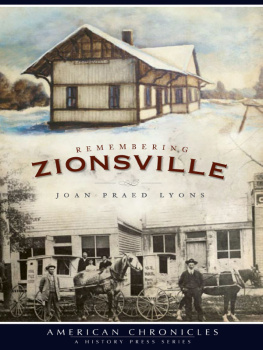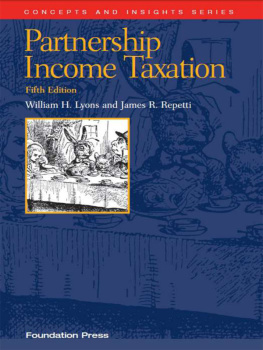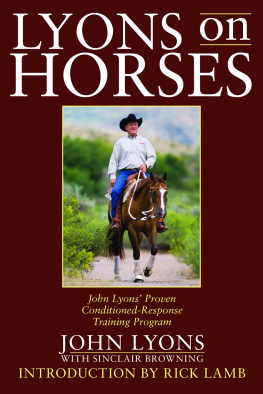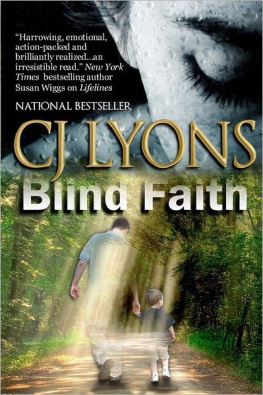

Published by The History Press
Charleston, SC 29403
www.historypress.net
Copyright 2009 by Joan Praed Lyons
All rights reserved
First published 2009
Second printing 2012
e-book edition 2013
Manufactured in the United States
ISBN 978.1.62584.250.3
Library of Congress Cataloging-in-Publication Data
Lyons, Joan Praed.
Remembering Zionsville / Joan Lyons.
p. cm.
print edition ISBN 978-1-59629-667-1
1. Zionsville (Ind.)--History. 2. Zionsville (Ind.)--Social life and customs. 3. Community life--Indiana--Zionsville--History. 4. Zionsville (Ind.)--Biography. 5. Oral history--Indiana--Zionsville. I. Title.
F534.Z46L97 2009
977.254--dc22
2009019601
Notice: The information in this book is true and complete to the best of our knowledge. It is offered without guarantee on the part of the author or The History Press. The author and The History Press disclaim all liability in connection with the use of this book.
All rights reserved. No part of this book may be reproduced or transmitted in any form whatsoever without prior written permission from the publisher except in the case of brief quotations embodied in critical articles and reviews.
CONTENTS
ACKNOWLEDGEMENTS
This book would not exist without the individuals and organizations that were willing to share personal knowledge or facilities that provided the history recorded on these pages. Since one is no more important than another in the collective whole, Ill start with the person who first ignited my interest in Zionsville history.
Sandra Brock Cline was editor and publisher of the Zionsville Times Sentinel in 1986, when Indiana governor Robert Orr unveiled his plan to encourage the smaller communities in the state to: 1) find a way to celebrate the history of the town; 2) develop a project that would improve their community; and 3) hold a celebration of those accomplishments in 1988. He called his plan Hoosier Celebration 88.
At that time, I had moved up through the ranks at the newspaper from accident reports to feature stories. Cline asked me if I would like to join her in a project that would result in an oral history of the community, for which we would need to involve as many people as possible. I agreed, but realized that, as an eight-year resident of the town, I would be expecting lifelong residents to entrust me with their stories and photos. I asked to introduce my weekly Past Times column to make their acquaintance and build their trust. Zionsville: The First One Hundred Years: An Oral History of the Community of Zionsville, Indiana, from 1852 to 1952 was the result. Past Times has extended far beyond its intended purpose, having recently celebrated twenty-three years. And now, thanks to The History Press, Past Times interviews will inform a wider audience.
Over the years Ive learned to depend on the Patrick Henry Sullivan Museum, a part of the Sullivan/Munce Cultural Center, and its repository of local history to verify information and to add the detailed facts few people store in their memory banks. Marianne Doyle was particularly helpful in introducing me to the numerous means available to satisfy my needs. Most of the photographs that enhance the stories in this book came from museum archives.
Among the treasure-trove of information at the museum are reels of microfilm of the local newspaper from shortly after it was published for the first time in 1860 by A.G. Abbott. So, a huge thank-you to Mr. Abbott and to the many editors who have succeeded him, especially Greta Sanderson, current executive editor, who opened another door for me by inviting me to write five two-decade sections during the millennial year. Those sections, joined by another covering the period between Zionsvilles founding in 1852 and the end of the nineteenth century, became another book published on grants, in time for the towns sesquicentennial: Rails to Trails: 150 Years of Zionsville, Indiana, History.
I am especially grateful to the Hussey-Mayfield Memorial Public Library for installing my columns on its website, where I was discovered by The History Press.
I also deeply appreciate the advice and encouragement I have received from Stephen Anspaugh, retired teacher and leader of our writers group that meets monthly at the library.
CHAPTER ONE
THE RAILROAD: MID-NINETEENTH-CENTURY NUCLEUS OF A THRIVING COMMUNITY
EARLY SETTLERS WERE DRAWN TO THE RAILROAD AS IF TO A MAGNET
Just as transportation holds the key to development today, so it did in the early to mid-nineteenth century, when pioneers began to settle in this part of Indiana. As stalwart men and women sought homesteads on the frontier, they chose to settle first in those areas that were easier to reach.
Of course, there were those men who went on ahead of their families, literally by slashing their way through the heavy forestation, to prepare a track for the wagons that would follow. This was a lengthy task, fraught with all kinds of hardships and danger.
By 1827, work on the National Road, a public road that would cross the state from Richmond on the east to Terre Haute on the west, was in progress, and by 1830 a northsouth public road from Madison on the Ohio River to Lake Michigan, known as the Michigan Road, was begun. These roads made it much easier for settlers to make the journey from their homes in eastern or southern states to land they sought as homesteads.
The roads also opened the area to those traveling by stagecoach, and the frontier communities to goods that were transported by stage from such faraway cities as Cincinnati. A new industry was born, as the route followed by the stagecoaches needed regularly spaced facilities where the driver could stop to feed his passengers and horses, or to bed both at night.
Eagle Village became a stagecoach stop soon after the Michigan Road was completed to that point. As a result, the community flourished, with taverns, stores, tradesmen, churches and a school, untilthe railroad was laid about one mile west of the village.

The first depot serving the newly platted town of Zionsville was this rough structure essential to the Indianapolis, Cincinnati & Lafayette Railroad that was the nucleus of the new town. Courtesy of the Sullivan Museum.
William Zion, a businessman in Lebanon, the growing town to the north, was also a member of the board of directors of the Indianapolis, Cincinnati & Lafayette Railroad. He convinced Elijah and Mary Polly Cross that a town could and should be laid out on their Eagle Township land, through which the railroad would pass. Zion and Cross became partners as proprietors of the proposed town and drew a rough plan of their ideas.
James Mullikin, Boone County surveyor at the time, surveyed the site and drew up the original plat consisting of six full blocks, three half-blocks and five quarter-blocks, on approximately twenty-eight acres. Cross and Zion filed the report and chart he prepared in the Boone County recorders office on January 26, 1852.
According to the late Boone County historian Ralph Stark, writing in Birth Certificates of Boone County, The lots were each 60 by 120 feet in size. The streets were 60 feet wide with the exception of Water Street, which was 30 feet in width. The width of the railroad right-of-way was given as 50 feet.
Next page











